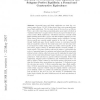Free Online Productivity Tools
i2Speak
i2Symbol
i2OCR
iTex2Img
iWeb2Print
iWeb2Shot
i2Type
iPdf2Split
iPdf2Merge
i2Bopomofo
i2Arabic
i2Style
i2Image
i2PDF
iLatex2Rtf
Sci2ools
CORR
2007
Springer
2007
Springer
Acyclicity of Preferences, Nash Equilibria, and Subgame Perfect Equilibria: a Formal and Constructive Equivalence
Abstract. Sequential game and Nash equilibrium are basic key concepts in game theory. In 1953, Kuhn showed that every sequential game has a Nash equilibrium. The two main steps of the proof are as follows: First, a procedure expecting a sequential game as an input is defined as “backward induction” in game theory. Second, it is proved that the procedure yields a Nash equilibrium. “Backward induction” actually yields Nash equilibria that define a proper subclass of Nash equilibria. In 1965, Selten named this proper subclass subgame perfect equilibria. In game theory, payoffs are rewards usually granted at the end of a game. Although traditional game theory mainly focuses on real-valued payoffs that are implicitly ordered by the usual total order over the reals, there is a demand for results dealing with non totally ordered payoffs. In the mid 1950’s, works of Simon or Blackwell already involved partially ordered payoffs. This paper further explores the matter: it general...
| Added | 13 Dec 2010 |
| Updated | 13 Dec 2010 |
| Type | Journal |
| Year | 2007 |
| Where | CORR |
| Authors | Stéphane Le Roux |
Comments (0)

